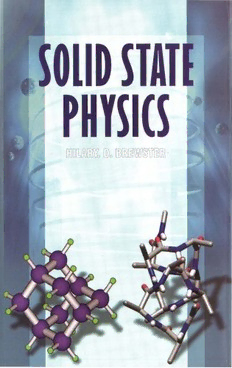
Solid State Physics PDF
Preview Solid State Physics
Solid State Physics Solid State Physics Hilary D. Brewster Oxford Book Company Jaipur, India ISBN: 978-93-80179-07-0 First Edition 2009 Oxford Book Company 267, lO-B-Scheme, Opp. Narayan Niwas, Gopalpura By Pass Road, Jaipur-3020l8 Phone: 0141-2594705, Fax: 0141-2597527 e-mail: [email protected] website: www.oxfordbookcompany.com © Reserved Typeset by: Shivangi Computers 267, lO-B-Scheme. Opp. Narayan Niwas. Gopalpura By Pass Road, Jaipur-302018 Printed at: Rajdhani Printers, Delhi All Rights are Reserved. No part of this publication may be reproduced, stored in a retrieval system. or transmitted, in any form or by any means. electronic, mechanical, photocopying, recording, scanning or otherwise, without the prior written permission of the copyright owner. Responsibility for the facts stated. opinions expressed, conclusions reached and plagiarism, ifany, in this volume is entirely that of the Author, according to whom the matter encompassed in this book has been originally created/edited and resemblance with any such publication may be incidental. The Publisher bears no responsibility for them, whatsoever. Preface Solid-state physics, the largest branch of condensed matter physics, is the study of rigid matter, or solids, through methods such as quantum mechanics, crystallography, electromagnetism and metallurgy. Solid-state physics considers how the large-scale properties of solid materials result from their atomic-scale properties. Solid-state physics thus forms the theoretical basis of materials science, as well as having direct applications, for example in the technology of transistors and semiconductors. The introductory text, written by author is designed to become a landmark in the field of solid state physics through its organized unification of key topics. This book provides necessary information about solid state physics. each topic discussed are explained with selected examples and diagrams. An extraordinarily readable writing style combines with chapter opening principles, study problems and beautiful illustration to make this book an ideal choice for students and teachers of physics. Hilary. D. Brewster Contents Preface v 1. Energy Dispersion Relations in Solids 1 2. Effective Mass Theory and Transport Phenomena 39 3. Electron and Phonon Scattering 98 4. Magneto-transport Phenomena 119 5. Transport in Low Dimensional Systems 133 6. Rutherford Backscattering Spectroscopy 150 7. Time-Independent Perturbation Theory 164 8. s and Electron-Phonon Interaction 173 9. Artificial Atoms and Superconductivity 178 10. Quantum and Statistical Mechanics 224 11. Broken Translational Invariance 242 12. Electronic Bands 263 Index 283 Chapter 1 Energy Dispersion Relations in Solids The transport properties of solids are closely related to the energy dispersion relations E (k) in these materials and in particular to the behavior of E (k) near the Fermi level. Conversely, the analysis of transport measurements provides a great deal of information on E (k). Although transport measurements donot generally provide the most sensitive tool for studying E (k), such measurements are fundamental to solid sthte physics because they can be carried out on nearly all materials and therefore provide a valuable tool for char-acterizing materials. To provide the necessary background for the discussion of transport properties, we give here a brief review of the energy dispersion relations E (k) in solids. In this connection, the two limiting cases of weak and tight binding. ONE ELECTRON E (k) IN SOLIDS In the weak binding approximation, we assume that the periodic potential V (r) = V (r + ~) is sufficiently weak so that the electrons behave almost as if they were free and the effect of the periodic potential can be handled in perturbation theory. In this formulation V (r) can be an arbitrary periodic potential. The weak binding approximation has achieved some success in describing the valence electrons in metals. For the core elec-trons, however, the potential energy is comparable with the kinetic energy so that core electrons are tightly bound and the weak binding approximation is not applicable. In the weak binding approximation we solve the SchrAodinger equation in the limit of a very weak periodic potential HiJ,.' E1\!. = Using time {independent perturbation theory we write E(k) = EO(k) + E(I) (k) + E(2)(k) + ... and take the unperturbed solution to correspond to V (r) = 0 so that E(O) (k)
